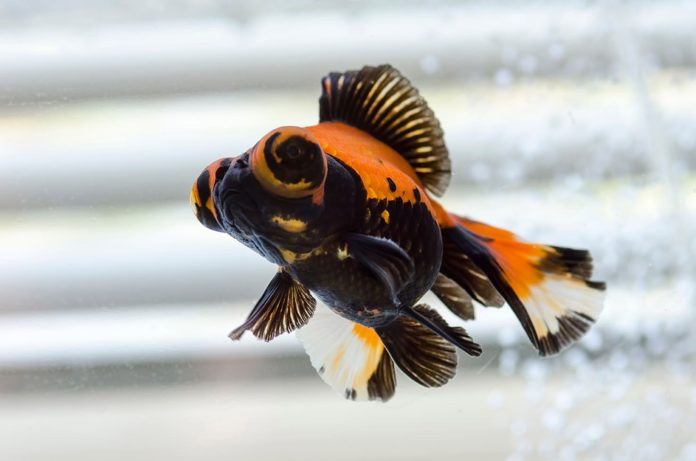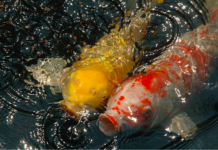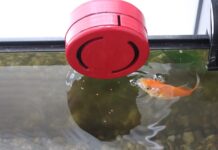Last Updated on February 3, 2024 by Fumipets
Unveiling the Elegance: The Enchanting World of Butterfly Goldfish
In the realm of ornamental fishkeeping, one captivating variety that stands out for its grace and beauty is the Butterfly Goldfish. Renowned for its distinct finnage and vibrant colors, this aquatic gem has become a sought-after choice among hobbyists and aquarists.
In this exploration, we embark on a journey into the fascinating world of Butterfly Goldfish, discovering the unique characteristics that make them a delightful addition to aquariums around the globe.
Butterfly Goldfish
One of the most attractive and distinctive kinds of fancy goldfish is the butterfly goldfish. This is a well-bred goldfish with unique characteristics and colours. Many goldfish aficionados like the range of colors and patterns available. Exotic goldfish, often known as butterfly goldfish, are normally only available from goldfish breeders. A butterfly goldfish of show quality will have proportional features and consistent colour.
Butterfly goldfish is ideal for goldfish owners who have some expertise with fancy goldfish ownership and care. This article will provide you with all of the information you want on the fascinating butterfly goldfish.
Quick Facts about Butterfly Goldfish
| Species Name: | Carassius auratus |
| Family: | Minnows and Carp |
| Care Level: | Intermediate |
| Temperature: | 62°F to 77°F |
| Temperament: | Peaceful |
| Color Form: | Black, red, white, orange, bronze, yellow |
| Lifespan: | 8 to 10 years |
| Size: | 6 to 8 inches |
| Diet: | Omnivore |
| Minimum Tank Size: | 20 gallons |
| Tank Set-Up: | Freshwater: filtered, decorated, substrate |
| Compatibility: | Species-only tank |
Butterfly Goldfish Overview
The butterfly goldfish is a Chinese species that was imported to Japan in the early 1980s and cultivated further to produce more prominent patterns and colors. This goldfish has bulging spherical eyes and is a version of the famous telescope goldfish. The key trait that distinguishes butterfly goldfish from other species of beautiful goldfish is its butterfly-shaped tail, which spreads out to create a butterfly when seen from above.
Many of the more costly types are imported from Asia, bred in the United States, and then marketed to the general public. They have a captivating body that attracts many goldfish judges, and numerous variations have won awards at goldfish events.
They’re a little harder to maintain than other fancier types, and they’re prone to swim bladder problems. They are excellent pets for anybody who can properly keep and feed them.

How Much Do Butterfly Goldfish Cost?
Specimens of butterfly goldfish may be fairly costly. This is due to the fact that they are not often produced for pet shops, therefore you may need to contact a goldfish breeder to get a good butterfly goldfish. The butterfly goldfish may cost anywhere from $20 to $80 depending on the design and colors. Shipping fees often range from $25 to $60, and when combined with the price of the goldfish, it may result in a greater price than other goldfish.
Typical Behavior & Temperament
Butterfly goldfish are placid fish with a low level of hostility. They thrive in groups with other elegant goldfish and form strong bonds with their owners. Butterfly goldfish are slow-moving fish which want to live in a big aquarium. If maintained in a tiny tank, they are quickly agitated, although they may also be kept in indoor or patio ponds. They seldom fin nip and don’t pay much attention to other fish. Butterfly goldfish with thick fins and bodies are more prone to float a few inches above the aquarium’s bottom and rest often.

Appearance & Varieties
The egg-shaped butterfly goldfish has a small, stubby body. The head is larger than the body, and it is equipped with a pair of telescopic eyes. When properly cared for and kept in huge pools of water, they may reach a size of 6 to 8 inches.
They live for an average of 8 to 10 years, although well-cared-for butterfly goldfish may live for up to 12 years. The butterfly trail is the species’ most notable characteristic. The goldfish’s status is determined by its tail, which should not be excessively little or huge in comparison to the rest of their body.
The tail is horizontally positioned, and the body is rather deep. The tail lobes are formed like outspread butterfly wings, which is a lovely complement to the rest of their appearance. The dorsal fins of the Ryukin goldfish are tall and contain a hump. The body resembles that of a Ryukin, and the butterfly goldfish was most likely created by breeding a telescope goldfish with another telescope goldfish.
They are available in a variety of designs and hues, including reds, whites, pandas, orange, and black.
How to Take Care of Butterfly Goldfish
Habitat, Tank Conditions & Setup
Tank/aquarium size
A regular rectangular tank of at least 20 gallons is required for butterfly goldfish. When placed in bowls, vases, or bio-orbs, they do not thrive. Tall aquariums are unsuitable for these goldfish, since they may suffocate. These goldfish have a hard time swimming and like to stay towards the bottom of the aquarium. They can’t acquire oxygen from the surface if the tank’s height exceeds its length. Adult butterfly goldfish thrive in kiddie pools that have been converted into goldfish habitats, ponds, and huge basins. At least a 40 gallon aquarium is required for fully developed adult butterfly goldfish.
Water temperature & pH
These goldfish can survive a wide range of temperatures, although they thrive in water that is somewhat warmer. The tank’s principal temperature should be between 62°F and 77°F (17°C and 25°C). For them to remain healthy, the pH should be between 6.0 and 8.0.
Substrate
Foraging on a substrate is a terrific method to enhance their life and stimulate activity for all goldfish species. Butterfly goldfish thrive with fine gravel or aquarium sand as a substrate. To avoid choking, the gravel should be small enough to fit in their mouths and readily spit out.
Plants
In their tank, butterfly goldfish should have a few live plants. This provides them with a fiber-rich snack that aids digestion. Live plants also provide them a place to hide and help them feel more at ease in their surroundings.
Lighting
Warm-toned lighting, rather than brilliant white LED lights, are preferred by butterfly goldfish. It is preferable to use a light with a warm orange glow, blue, or green hue. You may also utilize lights with a dusk and dawn setting that have a timer.
Filtration
Because butterfly goldfish are notoriously filthy, they demand a tank with a high level of filtration. They generate a lot of waste, which raises the bioload in their tank. They should have an aeration system as well as a filter, and they should change the water often.

Are Butterfly Goldfish Good Tank Mates?
Butterfly goldfish should be kept in a tank designed specifically for them. Other varieties of fish and shrimp do not get along with them. Butterfly goldfish thrive in the company of other exotic species like Orandas, Ranchu, Ryukin, Fantails, and Telescope goldfish.
Tropical fish and crustaceans should never be kept with them. When the goldfish get big enough, they will generally consume smaller tank mates since the temperatures are dramatically different. Large apple snails are a suitable tank companion for butterfly goldfish. The goldfish will devour the smaller snails, putting them at danger of choking.
Suitable
• Fancy goldfish
• Apple snails
• Adult mystery snails
Unsuitable
• Cichlids
• Danios
• Tetras
• Oscars
• Mollies
• Bettas
• Platys
• Swordtails
• Red-tailed sharks
• Plecos
• Loaches
• Corydoras
What Should You Feed a Butterfly Goldfish?
Natural omnivores, butterfly goldfish need a diet rich in both plant and protein-based materials. As a staple diet, a portion of high-quality food is advised, with living foods and supplements served as snacks.
The high protein content of a butterfly goldfish’s food might cause digestive issues like constipation. To improve digestion and reduce their risks of getting bloat, they need a lot of plant and algal elements. Excess bloat may create issues with their swim bladder organs, causing them to become unbalanced in the water.
Healthy snack options include deshelled peas, blanched romaine lettuce, spinach, zucchini, and cucumber. Live or freeze-dried items like bloodworms, insect larvae, tubifex worms, or brine shrimp may be fed to your butterfly goldfish. Protein levels in juvenile goldfish should be greater since they will be using the nutrients to develop. When they reach the age of two, the protein amount should be reduced.

Taking Care of Your Butterfly Goldfish
Step 1: Get a big tank for your butterfly goldfish. Follow the simple rule of 20 gallons for one juvenile butterfly goldfish and 10 gallons for each additional goldfish when stocking. If you’re going to keep your butterfly goldfish in a pond, make sure it’s spherical to prevent them from getting stuck in tight corners.
Step 2: Install a powerful filter in your butterfly goldfish’s tank to house helpful microorganisms that convert ammonia to nitrates. Before introducing your new butterfly goldfish, the tank should be cycled for several weeks.
Step 3: To enhance oxygenation, keep an air stone within the tank. To ensure aeration for your butterfly telescopes, the surface should be continually moving.
Step 4: Use a liquid testing kit to test the water. 0 ppm ammonia and nitrite, and 5 to 25 ppm nitrate, according to the measurement. Weekly water changes are recommended to reduce the build-up of contaminants in the water.
Step 5: To meet the nutritional demands of butterfly goldfish, feed them a nutritious and comprehensive diet. Freshness is essential in all meals, and commercial items should be consumed long before their expiration date. Soaking items before feeding can leech out the nutrients that your goldfish need.
Breeding
Butterfly goldfish should be kept in mixed groups of males and females in order to reproduce properly. A three-to-one female-to-male ratio will suffice. You should set up a breeding tank or spawning mop to provide a safe haven for their eggs and young. Butterfly goldfish have no maternal instincts and will devour their young. The breeding tank should include a heater, filter, and aeration system.
If you want your butterfly goldfish to reproduce, offer them live meals every other day and gradually raise the temperature over the course of a week. They’ll be encouraged to spawn as soon as the temperature lowers again, and the female will lay her eggs throughout the tank’s plants. The eggs will subsequently be fertilized by the male butterfly goldfish. External fertilization is used, and both genders are necessary in the breeding process.
Is a Butterfly Goldfish Aquarium a Good Idea?
Butterfly goldfish are a fantastic stocking choice if you have a big tank with a filter and aeration system. They will offer character and color to a variety of domestic tanks or ponds, as well as a captivating view from above and on the side.
Butterfly goldfish may be added to existing aquariums that already include fancy goldfish. They’ll get along with a variety of goldfish varieties and appreciate the companionship. We hope that this article has given you a better understanding of the butterfly goldfish’s needs!
Questions and Answers on Butterfly Goldfish
What Sets Butterfly Goldfish Apart from Other Varieties?
Butterfly Goldfish are distinguished by their elongated, flowing fins that resemble delicate butterfly wings. This unique finnage sets them apart from other goldfish varieties, creating an ethereal and captivating appearance that adds an artistic touch to any aquarium.
What Colors and Patterns Can Be Found in Butterfly Goldfish?
These enchanting fish come in a spectrum of colors, ranging from vibrant oranges and reds to subtle shades of white and black. The Butterfly Goldfish may also display intricate patterns, adding to the visual allure. Their diverse color palette allows aquarium enthusiasts to choose specimens that complement their personal aesthetic preferences.
How Large Do Butterfly Goldfish Typically Grow?
While the size can vary among individual fish and specific subtypes, Butterfly Goldfish generally grow to a moderate size, making them suitable for various tank sizes. Their manageable size, coupled with their graceful appearance, makes them an excellent choice for both novice and experienced aquarists.
What Are the Ideal Tank Conditions for Butterfly Goldfish?
Butterfly Goldfish thrive in well-maintained aquariums with ample space for swimming and exploring. They prefer water temperatures within the range of 65-72°F (18-22°C) and appreciate a well-filtered environment. Adequate hiding spots and a balanced diet contribute to their overall health and well-being.
Can Butterfly Goldfish Coexist with Other Fish Species?
Butterfly Goldfish generally exhibit peaceful behavior, making them suitable tankmates for other compatible fish species. However, it’s crucial to consider the size and temperament of potential tankmates, ensuring a harmonious cohabitation. Additionally, providing sufficient space and monitoring interactions will contribute to a thriving community aquarium.


















